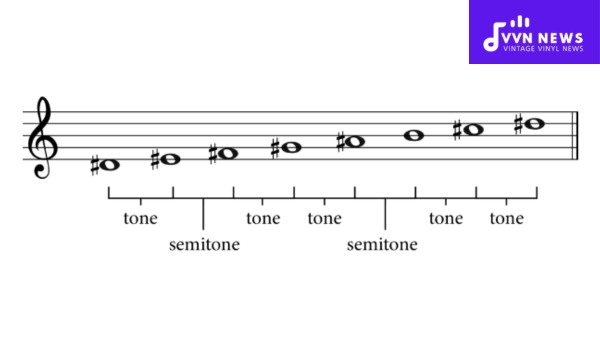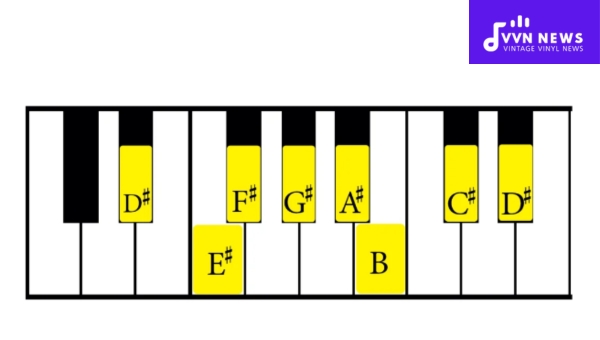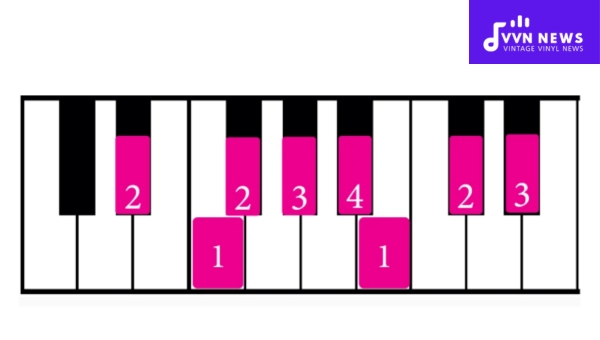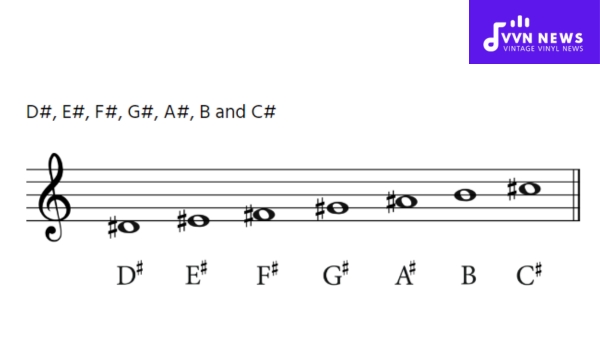When the world of scales captures your interest, there are many paths to journey down. Today, I’d like to take you on a trek towards a D sharp minor scale, one of those captivating, yet often overlooked scales in musical theory.
Have you ever been intrigued by the melodic harmonies and resonating chords produced on a piano or guitar? Those magical notes come to life as the fingers of the musician skillfully navigate various scales, including our focus today – the D sharp minor scale.
This particular scale holds its charm and can set an enchanting atmosphere that pulls at our heartstrings and kindles our emotions. The exciting expedition into this intriguing realm of music begins here!
What steps are involved in constructing the D Sharp Minor Scale?
When embarking on the journey of constructing the D Sharp Minor scale, envision yourself crafting a unique auditory tapestry, stitch by stitch. First and foremost, it’s imperative to grasp that we’re dealing with the natural minor form.
This means that our scale shall follow a specific pattern of whole and half steps: whole, half, whole, whole, half, whole, whole.
Steps to Forge the Scale:
- Start with the root note: D♯.
- Move a whole step to E♯, which would be played as an F on most instruments.
- Proceed a half step to reach F♯.
- Advance another whole step to find G♯.
- Leap further a whole step to A♯.
- Close in with a half-step march to B.
- Finally, two more whole steps will carry you through C♯, landing lastly on D♯, an octave higher.
Each step paves the way for the soul-stirring melody that is sure to emerge once you have mastered this scale’s flow.
Also Read: Harmony In Music [Enhance Your Compositions With These Tips]
Scale Degrees of the D Sharp Minor Scale
The D sharp minor scale, when dissected, reveals a series of steps between its notes.

Each step represents a scale degree, which serves as a unique position within this seven-note sequence. Here’s a quick guide highlighting these musical stepping stones:
- D# (Root): The foundational start and finish line of our scale odyssey.
- E# (Major Second): A whole step from the root, it provides an uplifting transition.
- F# (Minor Third): A half step from E#, it introduces the signature minor quality.
- G# (Perfect Fourth): Maintaining equilibrium, it’s a whole step above F#.
- A# (Perfect Fifth): Another whole step brings us to this harmonically stable note.
- B (Minor Sixth): This is where we feel the emotive pull through another half-step rise.
- C# (Minor Seventh): Finally, a whole step leads us to the last degree before repeating.
Review these positions to anchor your grasp on the structure of the D sharp minor scale confidently.
Grasping the D Sharp Minor Scale on Piano and Guitar
When it comes to producing enchanting music, getting a firm grip on how to navigate musical scales is key.
Let’s unravel the intricacies of the D Sharp Minor Scale fingerings on both piano and guitar.
On a Piano
To provide an optimal guide, let’s isolate the D Sharp Minor scale into two main forms – natural and harmonic.
The D natural sharp minor scale on piano follows the pattern of 2 – 1 – 2 – 2 – 1 – 2 – 2 half steps (semitone intervals). This results in the note sequence: D# – E# (F) – F# – G# – A# -B (Cb) – C# (Db) – D#.
To explain further, here are the steps to play this scale:
- Begin by placing your right thumb on D#, your third finger on F#, and then your pinky finger on A#.
- Swing your thumb under to hit the B, then proceed with the second finger on C#, the third finger on D#, the fourth finger on F#, and finally land your pinky back down again at G#.
- For the left hand: begin with pinky on high D#, run down to pointer at B, thumb lands softly at A#. Then smoothly transition by crossing the third finger over to reach G#. You’ll then use one finger per note until you land softly back down at low D# again.
On D harmonic sharp minor scale, we raise the seventh note one-half step which gives us Cx(B) instead of C#.
The finger pattern is still somewhat similar with just alterations where necessary due to this change.
On a Guitar
The complexities of mastering scales on a guitar can be intimidating, but with dedication and patience, it becomes second nature.
There are various ways you can approach scales depending on guitar type (Classical or Electric/Acoustic), player level (Beginner/Intermediate/Advanced), and playing style.
Nonetheless, for beginners, I’ll suggest a basic open position fingering for this scale that starts from the open 6th string or low E.
- Start by playing open low E (which is also E#),
- On the same string, use your 2nd finger to play F#, followed by your 4th finger to play G#.
- Move on to the A string and follow a similar pattern: open A (A#), index for B, middle for C#, followed finally by pinky on D#.
- The unique pattern continues on the D and G strings but instead finishes on D# using your pinky in the B string.
Playing scales in different positions and variations is recommended as you grow.
With passion, it’s not impossible to master this beautiful and versatile piece – The D Sharp Minor Scale.
How is the D Sharp Minor Scale notated in various clefs?
In music, the clef is a symbol placed on the left side of the stave, indicating the pitch of the notes written on it.

It’s through these clefs that we interpret the D Sharp Minor scale.
Treble Clef
Firstly, let’s discuss how this scale appears in treble clef. Recall that treble clef (also known as G clef) is used for high and medium pitch ranges.
When notated in treble clef, our D Sharp Minor scale follows this sequence:
D♯ – E♯ – F♯ – G♯ – A♯ – B – C♯ – D#.
Here, we have seven different tones with two sharps – D sharp and E sharp.
Bass Clef
Switching gears to focus on bass clef (or F clef), you might ask yourself how this would impact our beloved scale.
Notes played in bass clef for lower ranges. Here is what a D# minor looks like in a bass clef:
D♯ – E♯ – F♯ – G♯ – A♯ – B – C♯ – D#.
The sequence remains unchanged; it’s being played at an octave or more below middle C.
Alto and Tenor Clefs
If alto or tenor clef notation holds your curiosity as they occupy the medium range between treble and bass, I’m here to walk you through it. The same sequence of notes laid out above takes on new life when applied to these two additional ways to transcribe our enchanting ditty:
D♯- E#– F#– G#– A#– B- C#- D#
As your journey into music evolves, you’ll find an appreciation for each pitch, like different personalities contributing to an ensemble. Every clef uses the same configuration of tones for D Sharp Minor, with the only variations being the pitch range where it is played.
It’s like looking at a painting from different angles – each perspective adds new layers of depth.
Also Read: D Sharp Major Pentatonic Scale [A Bright And Positive Tone]
Key Signature for the D Sharp Minor Scale
In the realm of music, each minor scale is linked with a unique key signature. For the D sharp minor scale, the key signature holds nine sharps: F#, C#, G#, D#, A#, E#, B#, F## (or G), and C## (or D).
This alone characterizes its distinctness, as it’s one of the very few scales to utilize double sharps. The key signature sets the tonality and provides a roadmap for musicians to create harmonious tunes.
Armed with this knowledge, you’re now geared towards exploring the rich spectrum of melodies within this enchanting minor scale.
Which Major Key is Relative to the D Sharp Minor Scale?
Delving into the world of relative keys, we find an interesting relationship between each minor scale and a specific major scale.

In music theory, these are keys that share the same key signature. Our focus, the D sharp minor scale, holds a close kinship with F sharp Major.
These two scales consist of identical notes – differing only in the root from which their scale starts and ends.
While you play compositions or improvise, knowing this connection can be an invaluable tool — enhancing your ability to interchangeably utilize both scales for richer musical expressions.
D Sharp Minor Scale Primary Chords
The three primary chords in the D Sharp minor scale are typically notated as i, iv, and v or i, IV, and V. In this context:
- The tonic or root chord (i) would be D#m (D sharp minor). This includes D#, F#, and A#.
- The subdominant chord (iv) would be G#m (G sharp minor). This contains G#, B, and D#.
- The dominant chord, depending on whether you’re working in a harmonic or natural minor context could either be A#m (A sharp minor – v) comprising of A#, C#, E# or an A#M (A sharp major – V), consisting of A#, C##, E#.
Each of these chords provides a unique color to your music when composing within the D Sharp minor scale.
Also Read: G Major Blues Scale [Expand Your Harmonic Possibilities]
FAQs
What is the relative major of the D sharp minor scale?
The relative major of the D sharp minor scale is F sharp major.
How many sharps are there in the key signature of D sharp minor?
The key signature of D sharp minor contains six sharps.
Is the D sharp minor scale commonly used in compositions?
Due to its complexity, it’s less common but can be found in works by composers seeking a rich, dark sound.
Can you switch between harmonic and melodic versions within a piece?
Yes, composers often use harmonic for a poignant feel and melodic for smoother ascents or descents.
Why might a musician choose to write in E flat minor instead of D sharp minor?
They might find it easier to read or want to limit the number of accidents.
Also Read: D Minor Triad [A Crucial Element In Music Composition]
Conclusion
Embracing the D sharp minor scale can enrich a musician’s repertoire with its emotive power. With each note, whether played as part of a soul-stirring sonata on piano or strummed through a poignant piece on guitar, this scale can evoke profound feelings within an audience.
As you leave this guide behind and forge onward, keep in mind the stepwise construction, the related chords, and the key signature unique to this wondrous scale.








